Page 406 of 522
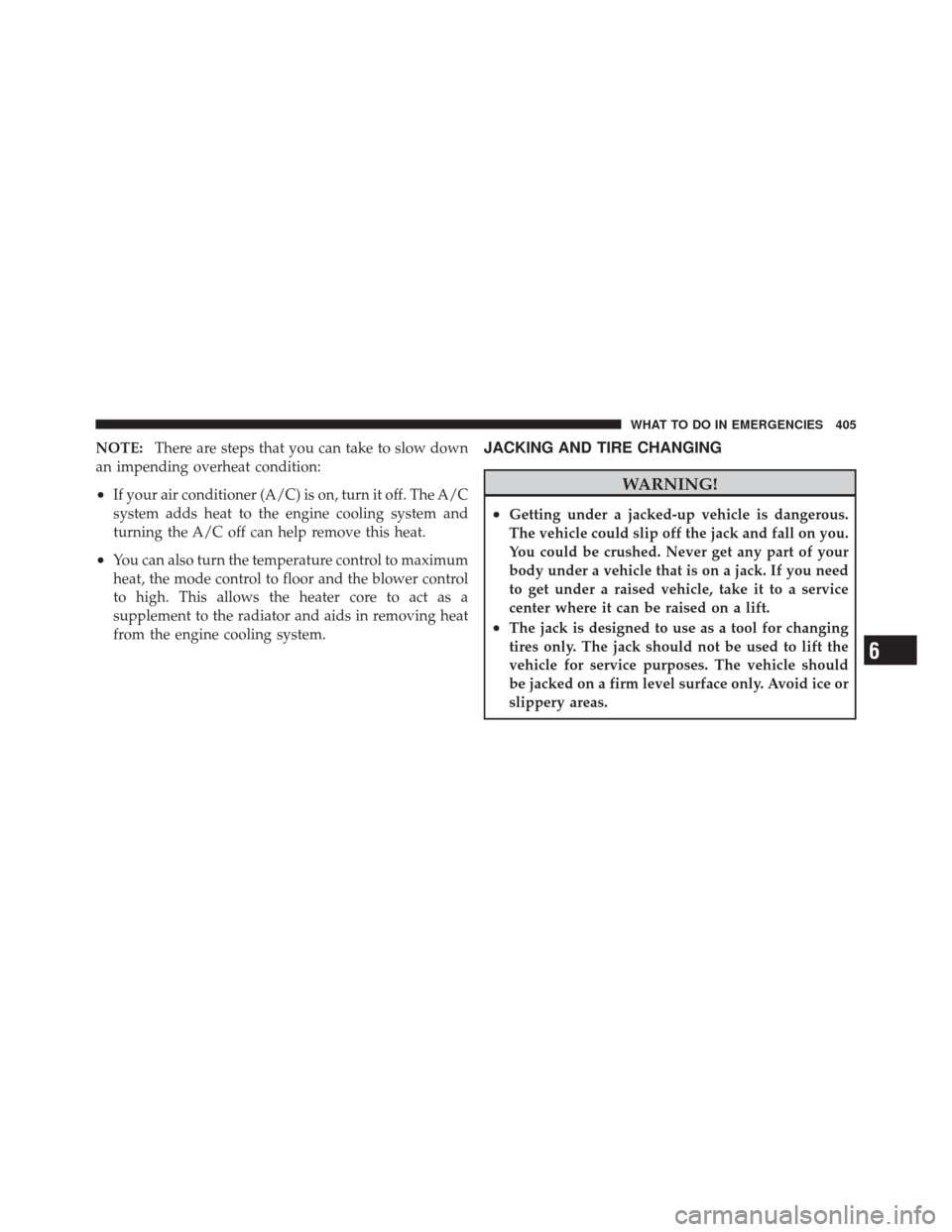
NOTE:There are steps that you can take to slow down
an impending overheat condition:
•If your air conditioner (A/C) is on, turn it off. The A/C
system adds heat to the engine cooling system and
turning the A/C off can help remove this heat.
•You can also turn the temperature control to maximum
heat, the mode control to floor and the blower control
to high. This allows the heater core to act as a
supplement to the radiator and aids in removing heat
from the engine cooling system.
JACKING AND TIRE CHANGING
WARNING!
•Getting under a jacked-up vehicle is dangerous.
The vehicle could slip off the jack and fall on you.
You could be crushed. Never get any part of your
body under a vehicle that is on a jack. If you need
to get under a raised vehicle, take it to a service
center where it can be raised on a lift.
•The jack is designed to use as a tool for changing
tires only. The jack should not be used to lift the
vehicle for service purposes. The vehicle should
be jacked on a firm level surface only. Avoid ice or
slippery areas.
6
WHAT TO DO IN EMERGENCIES 405
Page 418 of 522
MAINTAINING YOUR VEHICLE
CONTENTS
�Engine Compartment — 3.7L ............. 419
� Onboard Diagnostic System — OBD II ...... 420
▫ Loose Fuel Filler Cap Message ........... 420
� Emissions Inspection And Maintenance
Programs ............................ 421
� Replacement Parts ..................... 422
� Dealer Service ........................ 423
� Maintenance Procedures ................. 423
▫ Engine Oil ......................... 424 ▫
Engine Oil Filter ..................... 427
▫ Engine Air Cleaner Filter ............... 427
▫ Maintenance-Free Battery .............. 428
▫ Air Conditioner Maintenance ............ 429
▫ A/C Air Filter — If Equipped ........... 430
▫ Body Lubrication .................... 431
▫ Windshield Wiper Blades ............... 431
▫ Adding Washer Fluid ................. 432
▫ Exhaust System ..................... 433
7
Page 430 of 522
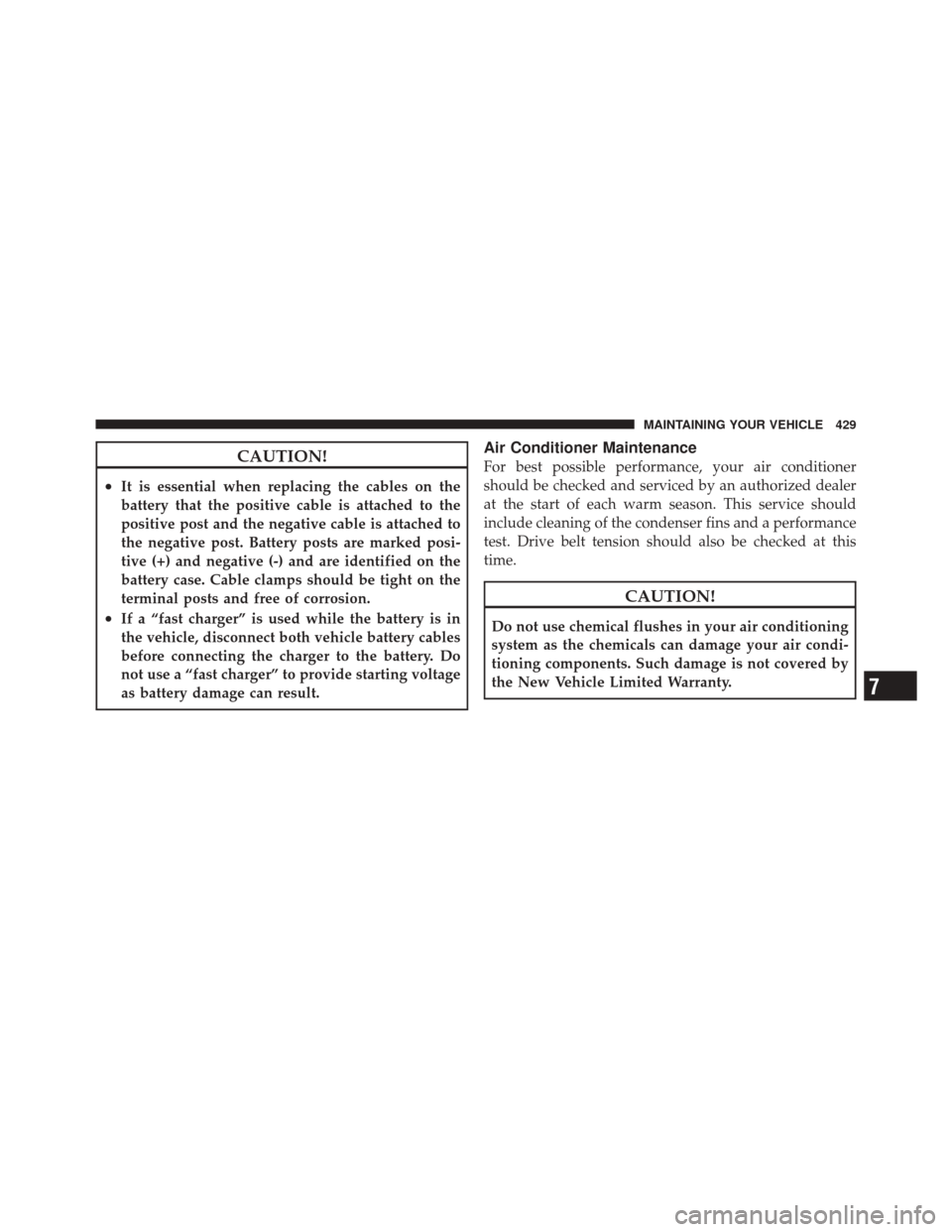
CAUTION!
•It is essential when replacing the cables on the
battery that the positive cable is attached to the
positive post and the negative cable is attached to
the negative post. Battery posts are marked posi-
tive (+) and negative (-) and are identified on the
battery case. Cable clamps should be tight on the
terminal posts and free of corrosion.
•If a “fast charger” is used while the battery is in
the vehicle, disconnect both vehicle battery cables
before connecting the charger to the battery. Do
not use a “fast charger” to provide starting voltage
as battery damage can result.
Air Conditioner Maintenance
For best possible performance, your air conditioner
should be checked and serviced by an authorized dealer
at the start of each warm season. This service should
include cleaning of the condenser fins and a performance
test. Drive belt tension should also be checked at this
time.
CAUTION!
Do not use chemical flushes in your air conditioning
system as the chemicals can damage your air condi-
tioning components. Such damage is not covered by
the New Vehicle Limited Warranty.
7
MAINTAINING YOUR VEHICLE 429
Page 431 of 522
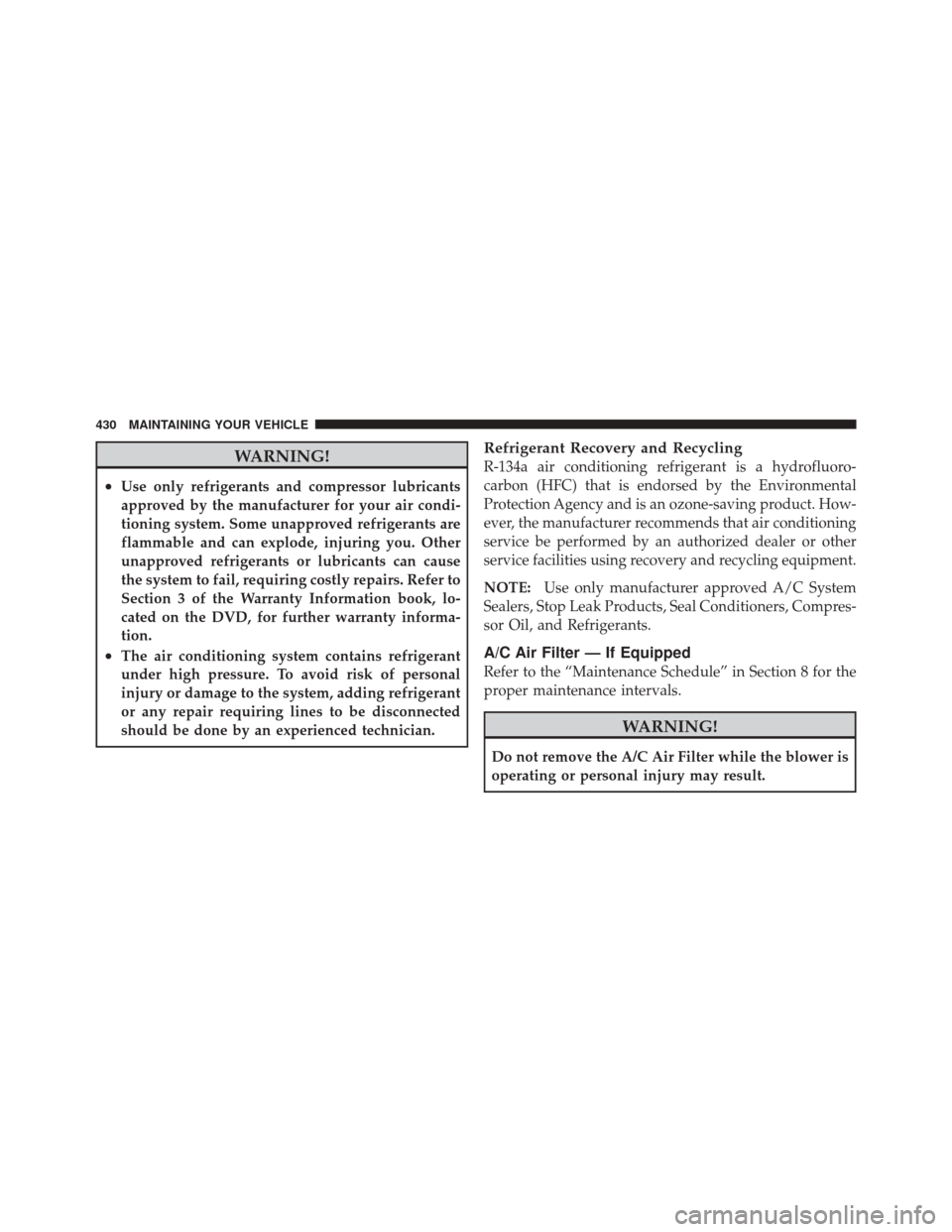
WARNING!
•Use only refrigerants and compressor lubricants
approved by the manufacturer for your air condi-
tioning system. Some unapproved refrigerants are
flammable and can explode, injuring you. Other
unapproved refrigerants or lubricants can cause
the system to fail, requiring costly repairs. Refer to
Section 3 of the Warranty Information book, lo-
cated on the DVD, for further warranty informa-
tion.
•The air conditioning system contains refrigerant
under high pressure. To avoid risk of personal
injury or damage to the system, adding refrigerant
or any repair requiring lines to be disconnected
should be done by an experienced technician.
Refrigerant Recovery and Recycling
R-134a air conditioning refrigerant is a hydrofluoro-
carbon (HFC) that is endorsed by the Environmental
Protection Agency and is an ozone-saving product. How-
ever, the manufacturer recommends that air conditioning
service be performed by an authorized dealer or other
service facilities using recovery and recycling equipment.
NOTE:Use only manufacturer approved A/C System
Sealers, Stop Leak Products, Seal Conditioners, Compres-
sor Oil, and Refrigerants.
A/C Air Filter — If Equipped
Refer to the “Maintenance Schedule” in Section 8 for the
proper maintenance intervals.
WARNING!
Do not remove the A/C Air Filter while the blower is
operating or personal injury may result.
430 MAINTAINING YOUR VEHICLE
Page 441 of 522
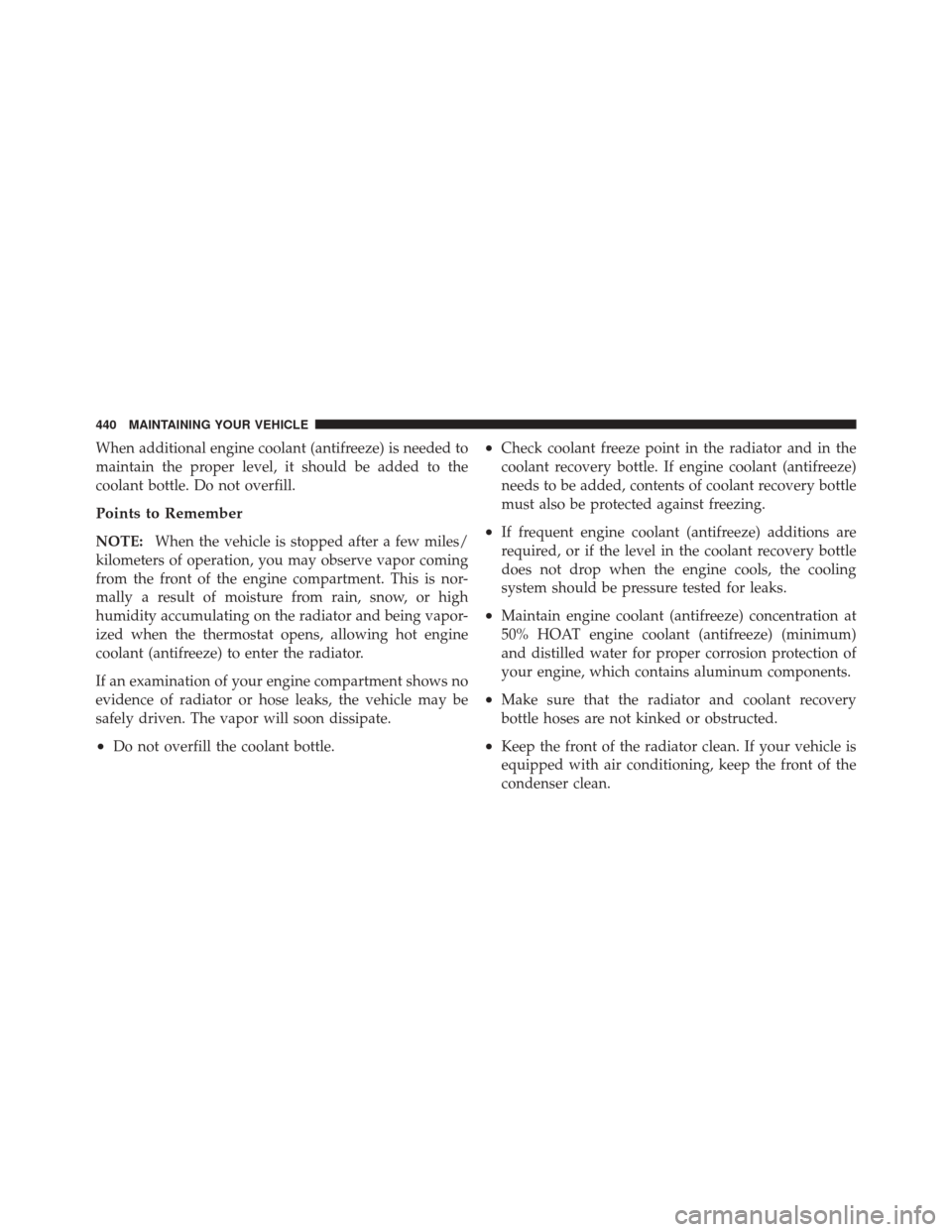
When additional engine coolant (antifreeze) is needed to
maintain the proper level, it should be added to the
coolant bottle. Do not overfill.
Points to Remember
NOTE:When the vehicle is stopped after a few miles/
kilometers of operation, you may observe vapor coming
from the front of the engine compartment. This is nor-
mally a result of moisture from rain, snow, or high
humidity accumulating on the radiator and being vapor-
ized when the thermostat opens, allowing hot engine
coolant (antifreeze) to enter the radiator.
If an examination of your engine compartment shows no
evidence of radiator or hose leaks, the vehicle may be
safely driven. The vapor will soon dissipate.
•Do not overfill the coolant bottle.
•Check coolant freeze point in the radiator and in the
coolant recovery bottle. If engine coolant (antifreeze)
needs to be added, contents of coolant recovery bottle
must also be protected against freezing.
•If frequent engine coolant (antifreeze) additions are
required, or if the level in the coolant recovery bottle
does not drop when the engine cools, the cooling
system should be pressure tested for leaks.
•Maintain engine coolant (antifreeze) concentration at
50% HOAT engine coolant (antifreeze) (minimum)
and distilled water for proper corrosion protection of
your engine, which contains aluminum components.
•Make sure that the radiator and coolant recovery
bottle hoses are not kinked or obstructed.
•Keep the front of the radiator clean. If your vehicle is
equipped with air conditioning, keep the front of the
condenser clean.
440 MAINTAINING YOUR VEHICLE
Page 449 of 522
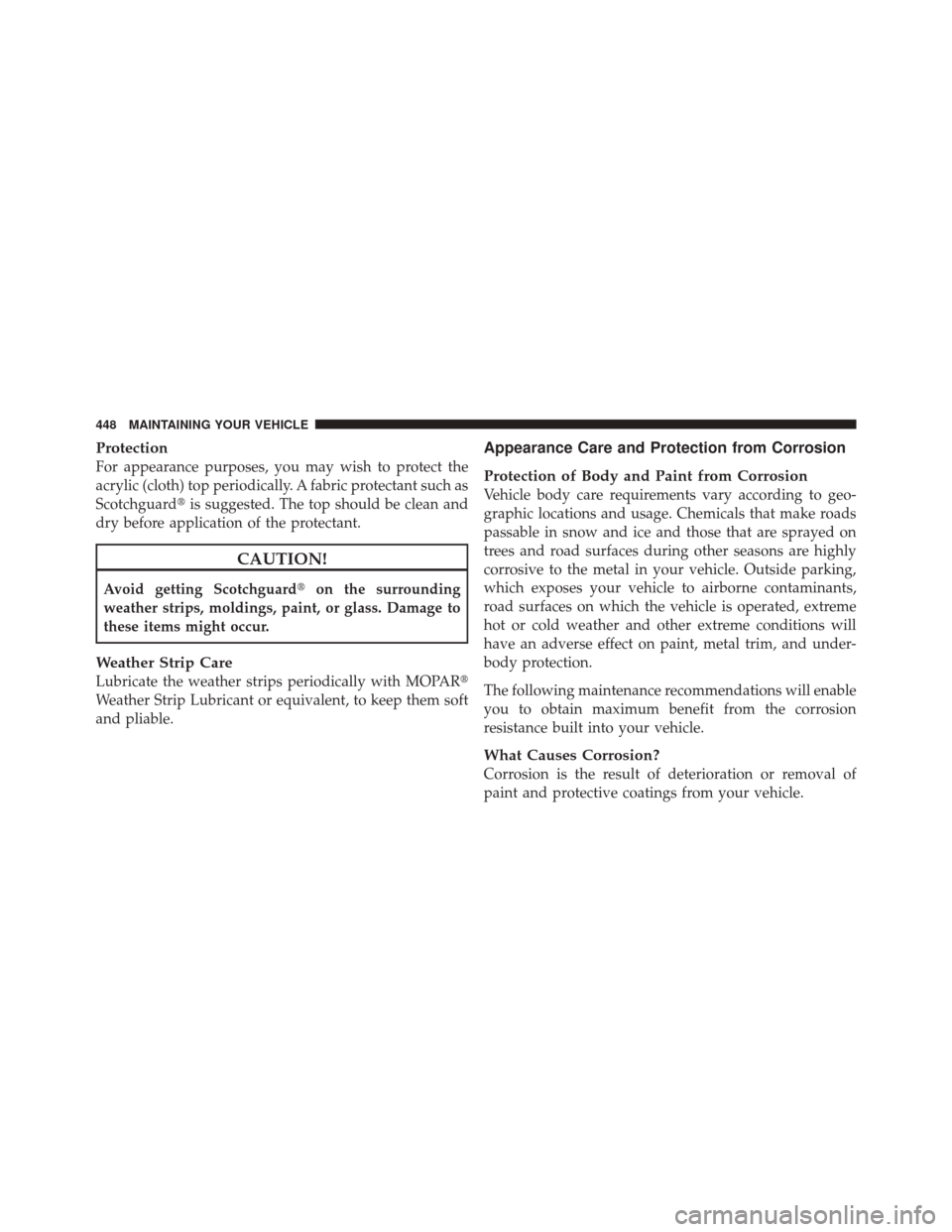
Protection
For appearance purposes, you may wish to protect the
acrylic (cloth) top periodically. A fabric protectant such as
Scotchguard�is suggested. The top should be clean and
dry before application of the protectant.
CAUTION!
Avoid getting Scotchguard� on the surrounding
weather strips, moldings, paint, or glass. Damage to
these items might occur.
Weather Strip Care
Lubricate the weather strips periodically with MOPAR �
Weather Strip Lubricant or equivalent, to keep them soft
and pliable.
Appearance Care and Protection from Corrosion
Protection of Body and Paint from Corrosion
Vehicle body care requirements vary according to geo-
graphic locations and usage. Chemicals that make roads
passable in snow and ice and those that are sprayed on
trees and road surfaces during other seasons are highly
corrosive to the metal in your vehicle. Outside parking,
which exposes your vehicle to airborne contaminants,
road surfaces on which the vehicle is operated, extreme
hot or cold weather and other extreme conditions will
have an adverse effect on paint, metal trim, and under-
body protection.
The following maintenance recommendations will enable
you to obtain maximum benefit from the corrosion
resistance built into your vehicle.
What Causes Corrosion?
Corrosion is the result of deterioration or removal of
paint and protective coatings from your vehicle.
448 MAINTAINING YOUR VEHICLE
Page 461 of 522
Cavity CartridgeFuseMini-
Fuse Description
M31 — 20 Amp YellowBack-Up Lights
M32 — 10 Amp RedOccupant Restraint
Controller (ORC)
M33 — 10 Amp RedPowertrain Control
Module (PCM)
M34 — 10 Amp RedPark Assist Module -
if equipped/Heating,
Ventilation, and Air
Conditioning (HVAC)
Module - if
equipped/Compass
Module - if equipped
M35 — 10 Amp RedHeated Mirrors - if
equipped
M36 — 20 Amp YellowPower Outlet #3
(BATT)Cavity Cartridge
FuseMini-
Fuse Description
M37 — 10 Amp RedAnti-Lock Brake Sys-
tem (ABS)/Electronic
Stability Program
(ESP) Module/Stop
Light Switch
M38 — 25 Amp NaturalDoor and Liftgate
Lock/Unlock Motors
CAUTION!
•When installing the Integrated Power Module
cover, it is important to ensure the cover is prop-
erly positioned and fully latched. Failure to do so
may allow water to get into the Integrated Power
Module, and possibly result in an electrical system
failure.
(Continued)
460 MAINTAINING YOUR VEHICLE
Page 471 of 522
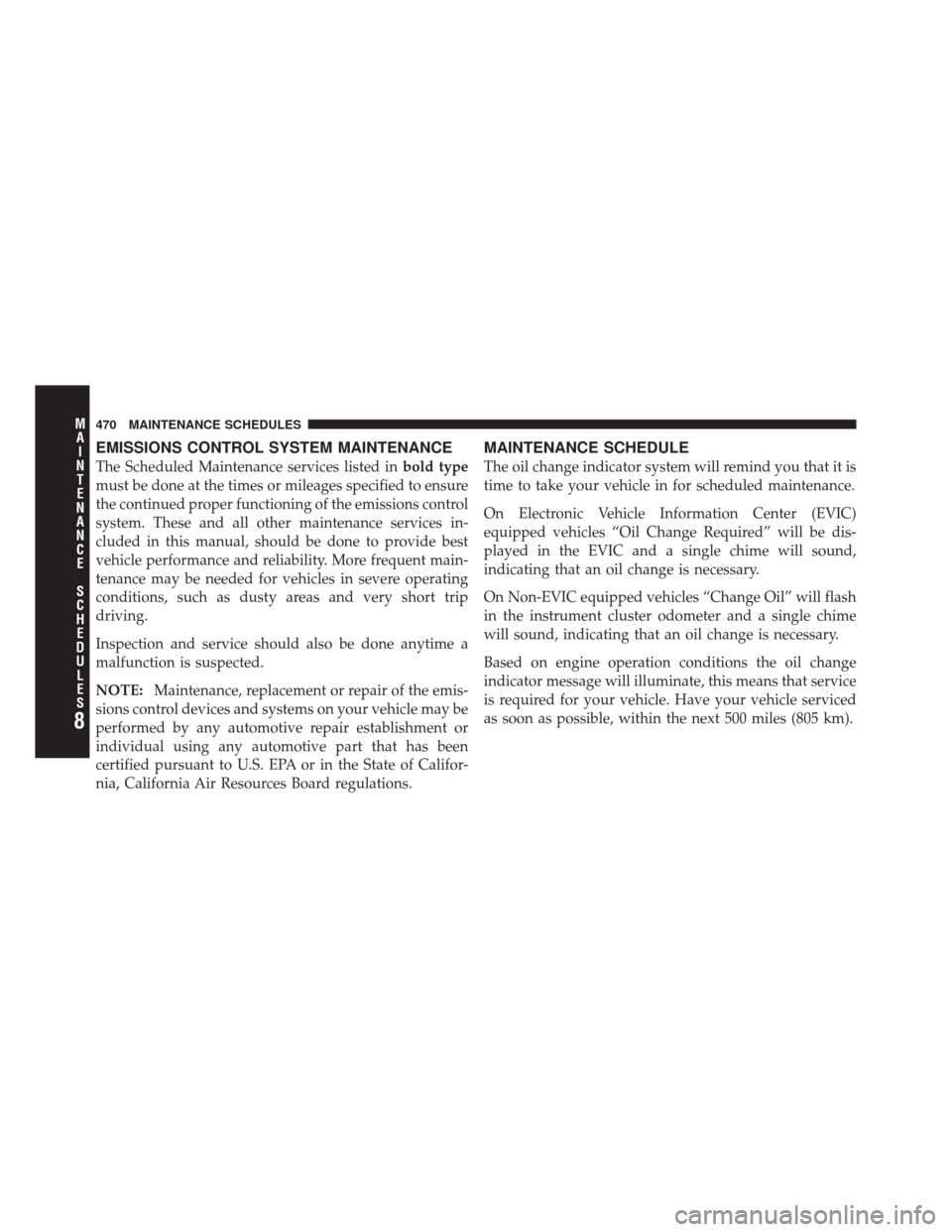
EMISSIONS CONTROL SYSTEM MAINTENANCE
The Scheduled Maintenance services listed inbold type
must be done at the times or mileages specified to ensure
the continued proper functioning of the emissions control
system. These and all other maintenance services in-
cluded in this manual, should be done to provide best
vehicle performance and reliability. More frequent main-
tenance may be needed for vehicles in severe operating
conditions, such as dusty areas and very short trip
driving.
Inspection and service should also be done anytime a
malfunction is suspected.
NOTE: Maintenance, replacement or repair of the emis-
sions control devices and systems on your vehicle may be
performed by any automotive repair establishment or
individual using any automotive part that has been
certified pursuant to U.S. EPA or in the State of Califor-
nia, California Air Resources Board regulations.
MAINTENANCE SCHEDULE
The oil change indicator system will remind you that it is
time to take your vehicle in for scheduled maintenance.
On Electronic Vehicle Information Center (EVIC)
equipped vehicles “Oil Change Required” will be dis-
played in the EVIC and a single chime will sound,
indicating that an oil change is necessary.
On Non-EVIC equipped vehicles “Change Oil” will flash
in the instrument cluster odometer and a single chime
will sound, indicating that an oil change is necessary.
Based on engine operation conditions the oil change
indicator message will illuminate, this means that service
is required for your vehicle. Have your vehicle serviced
as soon as possible, within the next 500 miles (805 km).
8
M A I
N T
E
N A
N CE
S
C
H E
D
U L
E
S470 MAINTENANCE SCHEDULES